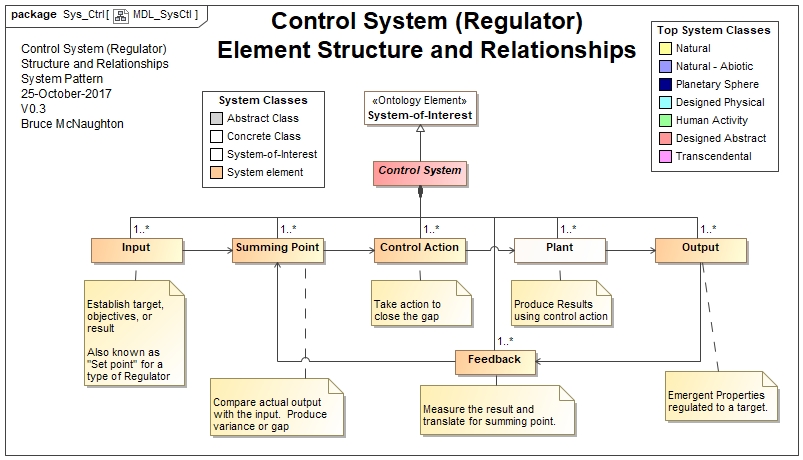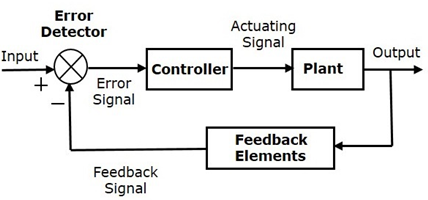Name: Control System
Based on: System (Abstract)
Abstract System: This system has been identified as an abstract system that cannot be implemented directly. The abstract system establishes a shared pattern of characteristics that any system can use to describe its unique characteristics when referenced in the 'based on' list above. These references are described using a generalization association in UML.
The Control System pattern is also known as a regulator.
A control system provides a way to manage a set of system properties within a target control range. The system makes use of feedback elements to sense and respond to changes in the outputs or results and take appropriate corrective action to maintain the desired state of the outputs. Typical control systems are:
- Thermostat for a room
- Statistical Process Control for a production process.
- Temperature in an oven
The control system is a type of regulatory system. These concepts are used in the Viable System Model (VSM).
System properties of the system are generally regulated as part of a control system.
Systemic Measurable Variables
The emergent properties created or used through the interaction of the elements. This includes both desired and undesired.
The following are typical variables for a control system:
- Reference Input: Command for specific action or output setting
- Feedback Signal: representation of the output at a given time
- Controlled output: the actual output value from the System.
- Actuating Signal: difference between the reference and the feedback signal
NOTE: the names vary depending upon the control system model used.
Systemic Capabilities or Functions
The capabilities of the control system are to provide a regulation capability of the Controlled Output variable. These functions are generally embodied in a combination of control elements and plant.
System States
The various defined states that the system-of-interest can be in.
- Architectural states: Generally defined in the enabling system
- Transformational States Generally defined in an enabling or adaptive system associated with the control system.
- Operational States: These are typically initialising, Reference input change, stable, shutting down.
Identify the key stakeholders and their concerns for this system. Each stakeholder is identified and their concerns and interests are identified. The list below is an example. Each system will have a specific set of stakeholders and concerns.
- Owner / manager: Is this a sustainable / stable system? will our customers be satisfied?
- System Architect: Are the system concepts understood? Are the system properties sufficient to deliver the objectives? Is the feedback mechanism sufficient to maintain / track outputs / outcomes?
- People in the environment Will the people confirm or use the benefits of the system?
- Change Agents Do we have the ability to change the system in a planned way?
- People who are part of the system Will I understand my contribution to the system?
The environment and the potential impacts on the system-of-interest.
this section includes
- Transactional: Ensure the delivery of the controlled output or respond to problems
- External Possible disruptions due to external factors: temperature, environment (e.g. flood, etc.).
- Regulator : Extra requirements or unexpected (magnitude or frequency) of changes to the reference inputs.
The system-of-interest consists of a number of identified system elements. .These are typically shown in a 'system breakdown structure'.

Each of the system elements may be defined in this section. The typical pattern for a control system is shown below:

Note: some of the system elements may be systems their own right. These systems may become a system-of-interest and may be described using a Link to the System Description Template.
The relationships or interactions are also shown in the diagram above and shows the way the system elements interact.
In this picture, the lines between the system elements are defined. These may represent formal interfaces, such as, communication interactions, protocols, information flows, Contracts, etc. In this section, the relationships may be defined.
The following approaches also have a similar pattern to the control system:
- P-D-C-A cycle Plan - Do - Check - Act
- SSM Learning Cycle (Page A55: from "A Thirty Year Retrospective)"
- Typical problem solving approaches: Six Sigma, Diagnose, Identify Solutions, Implement,
- Typical life cycle for ISO 15288: consisting of many feedback loops.
Configuration / Scenario:
Describes any configuration / scenario attributes for a specific system-of-interest. This may not be appropriate for all system descriptions (e.g. patterns or abstract systems).
Cyclical (Repeating / Regular) Processes
The processes to translate requirements and architecture into an operational system. An example of a set of life cycle processes can be found in ISO 15288.
NOTE: The Shannon Sampling Theorem applies to the dynamic behavior of the control system. If the sampling rate is too slow, the control system may become unstable or unable to control or regulate the process. The sampling rate is generally at least twice the underlying base frequency of the system being controlled.
Development Life Cycle Processes
This area describes the life cycle for creating, using or releasing a system. This allows for the replication of an existing system into other areas.
The following references support this type of system-of-interest.